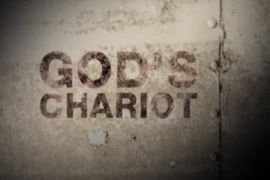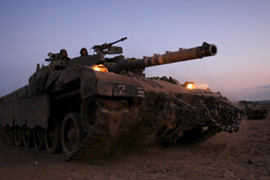
God’s Chariot
A look at Israel’s Merkava tank and the myth of Israeli military invincibility.
 |
Since it was first produced in 1979, Israel’s Merkava tank has gained a formidable reputation as one of the world’s best-protected fighting machines.
Yet, in the summer of 2006, Hezbollah guerrillas in Southern Lebanon shattered this image.
In just over a month 49 of Israel’s home-produced Merkava tanks – the symbol of the Jewish state’s military prowess – were reported damaged or destroyed.
It was not only the tank that was damaged, but the myth of Israeli military invincibility so central to the psychological warfare of the Arab-Israeli conflict.
The Merkava represents Israel’s technological superiority in conventional warfare, but in the new era of guerrilla war, is the Merkava an asset or a liability?
| Episode 1 |
Watch part two
On July 12, 2006, Hezbollah guerrillas in Southern Lebanon crossed the border into Israel and killed three Israeli soldiers. They captured two others.
 |
| An Israeli Merkava tank [EPA] |
Israel responded by sending in one of its celebrated Merkava tanks. It ran over a Hezbollah mine and was destroyed.
This dramatic moment marked the start of a full-scale war, the failure of which provoked a crisis in Israel’s military and political establishments.
The Merkava was designed as a result of a similar crisis: the near disaster of the 1973 (‘Yom Kippur’) war in which Israel suffered significant casualties.
The Israeli government charged General Israel Tal with designing a new tank to protect Israel’s soldiers and crush its enemies.
The Merkava was to be the best-protected tank in the world, but by the time it emerged in 1979, the military threat posed by Israel’s enemies was decreasing.
The Arab-Israeli war was entering a new stage, the relevance of tanks to which was unclear.
| Episode 2 |
At the turn of the 21st century the tactics Israel’s enemies were using against the Jewish state had changed.
Palestinians, ground down by years of occupation, advanced from the stone-throwing which had characterised the first intifada and began to launch attacks on one of the most powerful symbols of that occupation – the Merkava tank.
Several groups successfully destroyed the tank. It was no longer invincible. This was a lesson that would not be lost on Hezbollah in Lebanon.
During the 2006 war, Israel’s aim of crushing Hezbollah and preventing it from firing rockets into Israel failed.
Its Merkava tank proved ineffective against guerrilla fighters wielding anti-tank guided missiles.
Following the damage done to the Merkava’s prestige after the campaigns in the Occupied Palestinian Territories and Lebanon, questions are being raised in Israel over the project’s future, which has cost an estimated $6.5bn since its inception.
The Merkava – like the separation wall in the West Bank – represents the thesis that Israel’s security lies in military strength. The uncomfortable truth is that such an approach may be perpetuating the cycle of violence, rather than bringing the lasting peace most Israelis crave.
To contact us click on ‘Send your feedback’ at the top of the page or join our Your Views debates.
Click here to watch other Al Jazeera English programmes on Youtube